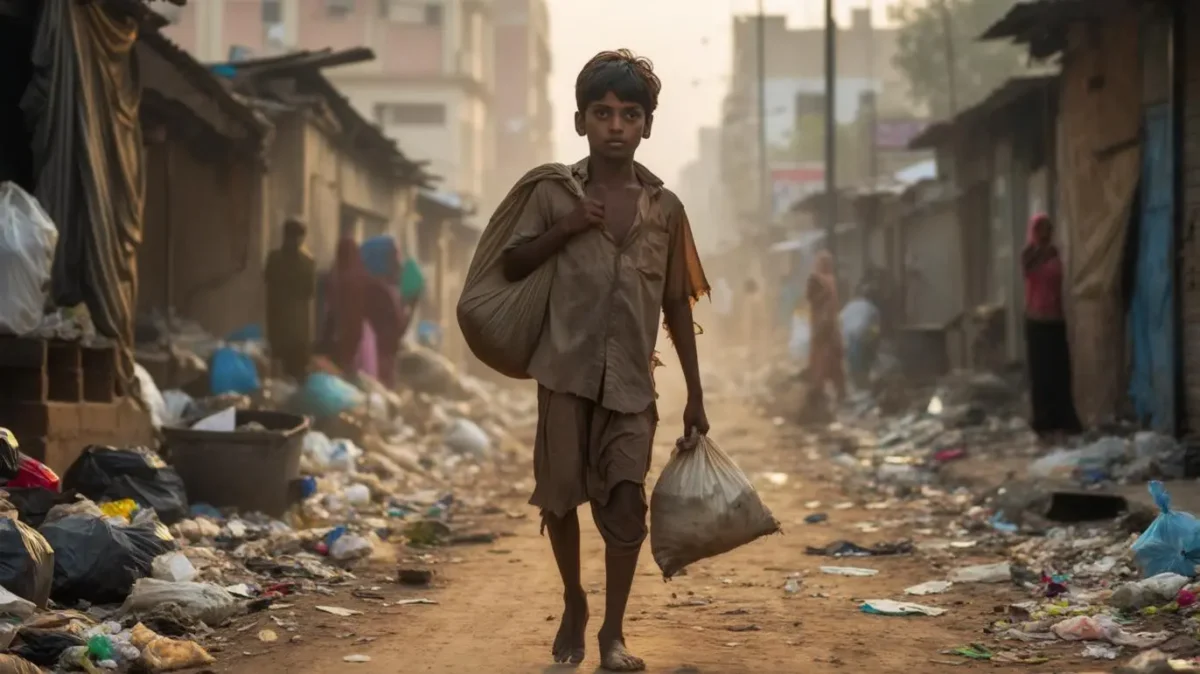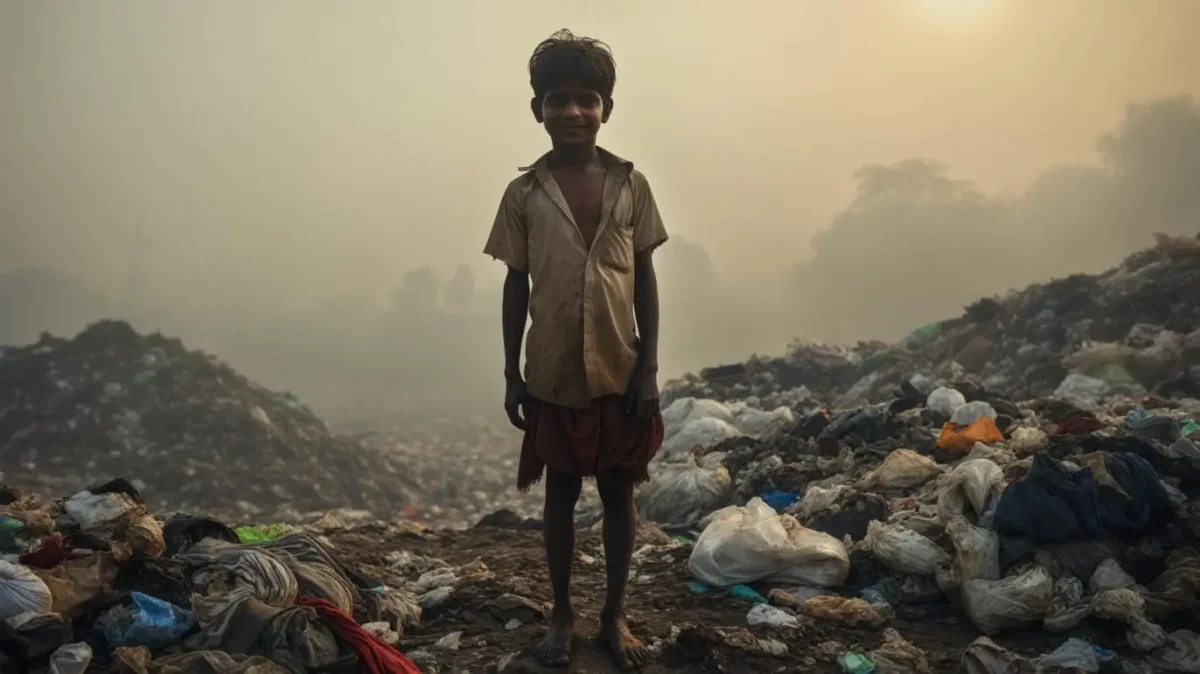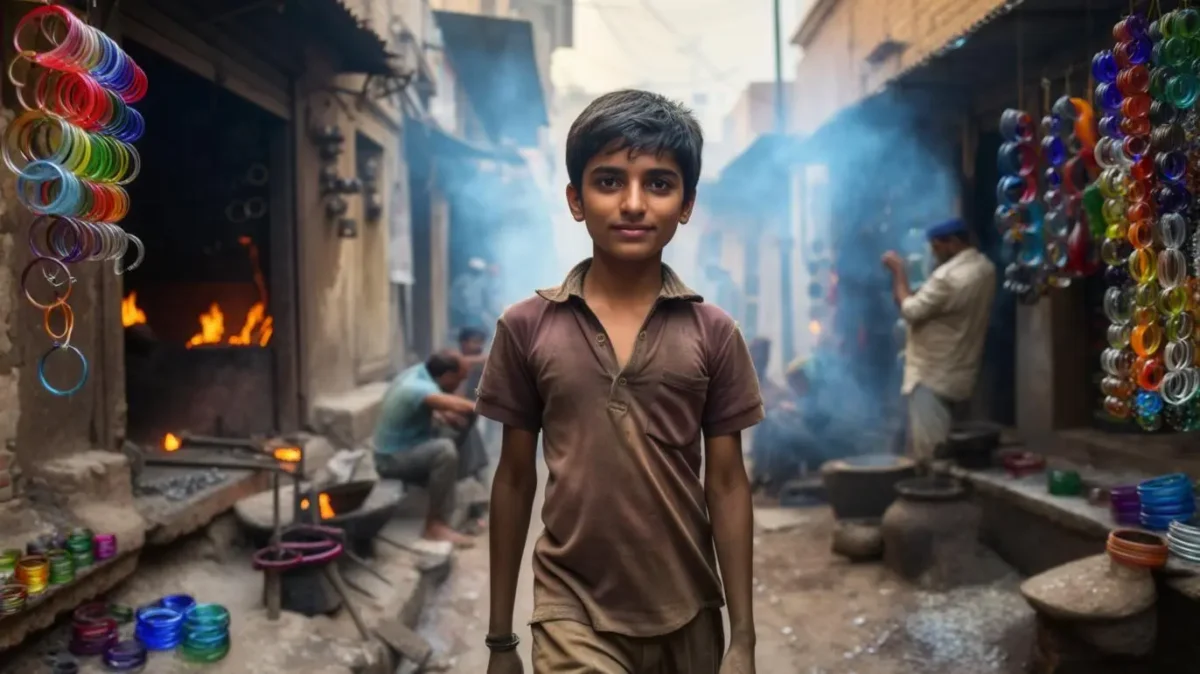"Lost Spring" by Anees Jung is a chapter in the AHSEC Class 12 English syllabus that vividly portrays the harsh realities of poverty and exploitation faced by children in India. The narrative is divided into two parts: the first focuses on Saheb, a ragpicker in Seemapuri, and the second on Mukesh, a young boy in Firozabad’s bangle-making industry. Through poetic prose, Jung highlights the loss of childhood, unfulfilled dreams, and systemic barriers like caste and economic exploitation that trap these children in cycles of poverty. The chapter emphasizes themes of hope, resilience, and the need to address social issues like child labour.
AHSEC Class 12 English Chapter 2 Lost Spring Question Answer | Flamingo Textbook HSLC 2025-26
Class 12 English Chapter 2 Lost Spring Question Answer – AHSEC 2025-26 Full Guide
Welcome to the complete set of Class 12 English Chapter 2 Lost Spring Question Answers designed specifically for AHSEC HS 2nd Year students. This guide includes key answers, explanations, and insights from Anees Jung’s powerful story "Lost Spring."
These Class 12 English Lost Spring Question Answers follow the AHSEC and NCERT guidelines, ideal for students appearing in 2025–26 HS final exams. You’ll find long answers, short questions, MCQs, character sketches, and literary device breakdowns—all focused on the theme of child labor and lost dreams.
Our bilingual resource (English & Assamese) ensures every learner understands the Lost Spring Class 12 Question Answer section clearly. This makes it one of the most exam-friendly tools for AHSEC students.
The Class 12 English Chapter 2 Lost Spring Question Answer section includes model answers that help boost writing and analysis skills. These solutions are crafted from real exam patterns and past year paper trends.
For deeper understanding, refer to the official NCERT English book at NCERT Class 12 Flamingo Textbook.
Learn more about child labor issues covered in the chapter by visiting UNICEF India – Child Protection.
Whether you are searching for AHSEC Class 12 English Lost Spring Question Answer, Chapter 2 Flamingo solutions, or exam-specific notes, this page covers all your academic needs for Lost Spring.
Explore Related Visuals – Class 12 English Chapter 2 Lost Spring Question Answer




Lost Spring: Question Answers
Table of Contents
Think as you read
1. What is Saheb looking for in the garbage dumps? Where is he and where has he come from?
চাহেবে আৱৰ্জনাৰ স্তূপত কি বিচাৰি ফুৰে? সি ক’ত থাকে আৰু ক’ৰ পৰা আহিছে?
Answer: Saheb is looking for valuable items like a rupee or a ten-rupee note in the garbage dumps, which he refers to as "gold." He is in Seemapuri, a place on the periphery of Delhi. He has come from Dhaka, Bangladesh, where his family left due to storms that swept away their fields and homes.
চাহেবে আৱৰ্জনাৰ স্তূপত মূল্যৱান বস্তু যেনে এটা টকা বা দহ টকাৰ নোট বিচাৰি ফুৰে, যাক সি "সোণ" বুলি অভিহিত কৰিছে। সি দিল্লীৰ ওচৰৰ এখন ঠাই ছিমাপুৰীত থাকে আৰু সি বাংলাদেশৰ ঢাকাৰ পৰা আহিছে য’ৰ পৰা তাৰ পৰিয়ালে ধুমুহাই পথাৰ আৰু ঘৰবোৰ ধ্বংস কৰা কাৰণে এৰি আহিছিল।
2. What explanations does the author offer for the children not wearing footwear?
লেখকে শিশুসকলে জোতা নিপিন্ধাৰ কাৰণ কি বুলি ব্যাখ্যা কৰিছে?
Answer: The author explains that the lack of footwear among children is not just due to a lack of money but also a tradition to stay barefoot. But she also questions it as possibly an excuse to explain away a perpetual state of poverty.
লেখকে কয় যে শিশুসকলে জোতা নিপিন্ধাটো কেৱল টকাৰ অভাৱ নুসূচায়। বৰঞ্চ খালি ভৰিৰে থকাৰ এটা পৰম্পৰাও হ’ব পাৰে। কিন্তু তেওঁ সেয়া স্থায়ী দৰিদ্ৰতাৰ ব্যাখ্যা হিচাপে এক অজুহাত হ’ব পাৰে বুলিও প্ৰশ্ন কৰিছে।
3. Is Saheb happy working at the tea-stall? Explain.
চাহেবে চাহৰ দোকানত কাম কৰি সুখী নে? ব্যাখ্যা কৰা।
Answer: Saheb is not happy working at the tea stall. His face has lost the carefree look he had when rag-picking, and the steel canister he carries seems heavier than the plastic bag he would carry so lightly. He is no longer his own master, as the canister belongs to the tea shop owner.
চাহেবে চাহৰ দোকানত কাম কৰি সুখী নহয়। তাৰ মুখৰ পৰা আৱৰ্জনা বিচাৰি ফুৰাৰ সময়ত থকা মুক্ত ভাৱটো নোহোৱা হৈছে, আৰু সি কঢ়িয়াই ফুৰা ষ্টীলৰ কেনিষ্টাৰটো যেন সি আগতে কঢ়িয়াই ফুৰা প্লাষ্টিকৰ বেগটোতকৈ ভাৰী যেন লাগিছে। সি এতিয়া নিজৰ মালিক নহয়, যিহেতু কেনিষ্টাৰটো চাহৰ দোকানৰ মালিকৰ।
4. What makes the city of Firozabad famous?
ফিৰোজাবাদ চহৰখন কিহৰ বাবে বিখ্যাত?
Answer: Firozabad is famous for its bangles. It is the centre of India’s glass-blowing industry where families have spent generations making bangles around furnaces for women in the land.
ফিৰোজাবাদ চহৰখন ইয়াৰ খাৰু নিৰ্মাণ উদ্যোগৰ বাবে বিখ্যাত। যিখন ভাৰতৰ কাঁচৰ খাৰু নিৰ্মাণৰ কেন্দ্ৰ হিচাপে পৰিয়ালসমূহে পুৰুষানুক্ৰমিকভাৱে এই দেশৰ মহিলাসকলৰ বাবে খাৰু নিৰ্মাণ কৰি আহিছে।
5. Mention the hazards of working in the glass bangles industry.
কাঁচৰ খাৰু উদ্যোগত কাম কৰাৰ বিপদসমূহ উল্লেখ কৰা।
Answer: The hazards of working in the glass bangle industry include high temperatures in the furnaces, working in dingy cells without air and light, and the hot furnaces where they slog their daylight hours, often losing the brightness of their eyes.
কাঁচৰ খাৰু উদ্যোগত কাম কৰাৰ বিপদসমূহৰ ভিতৰত আছে ভাটাৰ উচ্চ উষ্ণতা, বায়ু আৰু পোহৰ নথকা অন্ধকাৰ কোঠালিত কাম কৰা আৰু দীৰ্ঘদিন দিনৰ পোহৰৰ পৰা আঁতৰি গৰম ভাটাত থকাৰ ফলত প্ৰায়ে দৃষ্টিশক্তি হেৰুৱাই।
6. How is Mukesh’s attitude to his situation different from that of his family?
মুকেশৰ নিজৰ পৰিস্থিতিৰ প্ৰতি থকা দৃষ্টিভংগী তাৰ পৰিয়ালৰ পৰা কেনেকৈ পৃথক?
Answer: Mukesh’s attitude is different because he dares to dream of becoming a motor mechanic by rejecting the traditional bangle-making profession, while his family accepts their situation as their destined “karam”.
মুকেশৰ দৃষ্টিভংগী পৃথক আছিল কাৰণ সি মটৰ মেকানিক হোৱাৰ সপোন দেখাৰ সাহস কৰিছে আৰু পৰম্পৰাগত খাৰু নিৰ্মাণৰ পেচাক নাকচ কৰিছে। য’ত তাৰ পৰিয়ালে তেওঁলোকৰ পৰিস্থিতিক তেওঁলোকৰ নিয়তিৰ “কৰম” অৰ্থাৎ ভাগ্য হিচাপে গ্ৰহণ কৰিছে।
Understanding the text
1. What could be some of the reasons for the migration of people from villages to cities?
গাঁৱৰ পৰা চহৰলৈ মানুহৰ স্থানান্তৰৰ কিছুমান কাৰণ কি কি হ’ব পাৰে?
Answer: Some reasons for migration from villages to cities are natural disasters like storms that destroy fields and homes, as seen in Saheb’s family leaving Dhaka, lack of opportunities in villages, the search for better livelihood opportunities in cities, and the hope of finding work or food in cities, as seen with Seemapuri’s ragpickers.
গাঁৱৰ পৰা চহৰলৈ যোৱাৰ কিছুমান কাৰণ হ’ল এনেধৰণৰ: প্ৰাকৃতিক দুৰ্যোগ যেনে ধুমুহা যিয়ে পথাৰ আৰু ঘৰ ধ্বংস কৰে, যেনেকৈ চাহেবৰ পৰিয়ালে ঢাকা এৰি অহা দেখা যায়। গাঁৱত সুযোগ সুবিধাৰ অভাৱ। উন্নত জীৱিকাৰ সুযোগৰ সন্ধানৰ বাবে। কাম আৰু আহৰ পোৱাৰ আশাৰে আহে যেনেকৈ ছিমাপুৰীৰ আৱৰ্জনাত মূল্যবান বস্তু বিচাৰা ল’ৰা ছোৱালীবোৰৰ মাজত দেখা যায়।
2. Would you agree that promises made to poor children are rarely kept? Why do you think this happens in the incidents narrated in the text?
তুমি সন্মত হ’বানে যে দৰিদ্ৰ শিশুসকলৰ প্ৰতি কৰা প্ৰতিশ্ৰুতিসমূহ খুব কমেই পালন কৰা হয়? পাঠ্যটোত বৰ্ণিত ঘটনাৰ পৰা এনে কিয় ঘটে বুলি তুমি ভাবা?
Answer: Yes, promises made to poor children are rarely kept, as seen in the text when the author jokingly promises Saheb a school that she cannot provide. This happens because such promises are often made glibly without considering the practical challenges of poverty and lack of infrastructure.
হয়, দৰিদ্ৰ শিশুসকলৰ প্ৰতি কৰা প্ৰতিশ্ৰুতিসমূহ খুব কমেই পালন কৰা হয়, যেনেকৈ লেখকে চাহেবক হাঁহি-ধেমালিৰে এখন বিদ্যালয় খোলাৰ প্ৰতিশ্ৰুতি দিয়ে যিখন তেওঁ প্ৰদান কৰিব নোৱাৰে। সাধাৰণতে এনে ঘটে কাৰণ এনে প্ৰতিশ্ৰুতিসমূহ প্ৰায়ে দৰিদ্ৰতা আৰু পৰিকাঠামোৰ অভাৱবোৰ নোচোৱকৈ পোনপটীয়াকৈ বিবেচনা কৰা হয়।
3. What forces conspire to keep the workers in the bangle industry of Firozabad in poverty?
ফিৰোজাবাদৰ খাৰু নিৰ্মাণ কৰা উদ্যোগৰ শ্ৰমিকসকলক দৰিদ্ৰতাত ৰখাৰ বাবে কি কি শক্তিয়ে ষড়যন্ত্ৰ কৰে?
Answer: The workers in Firozabad’s bangle industry are kept in poverty by a web of forces including the stigma of their caste in which they are born, a vicious cycle of Sahukars, middlemen, policemen, keepers of law, bureaucrats, and politicians.
ফিৰোজাবাদৰ খাৰু নিৰ্মাণ কৰা উদ্যোগৰ শ্ৰমিকসকলক দৰিদ্ৰতাৰ জালত বিভিন্ন শক্তিৰ দ্বাৰা আৱদ্ধ কৰি ৰখা হয় য’ত আছে তেওঁলোকৰ জাতিৰ কলংক, যিয়ে তেওঁলোকক খাৰু নিৰ্মাণৰ মাজত সীমাবদ্ধ কৰে। আনহাতে মহাজনৰ দৰে দুষ্ট চক্ৰ, মধ্যস্থতাকাৰী, আৰক্ষী, আইনৰ ৰক্ষক, আমোলা, আৰু ৰাজনীতিবিদৰ।
Talking about the text
1. How, in your opinion, can Mukesh realise his dream?
তোমাৰ মতে, মুকেশে তাৰ সপোন কেনেকৈ বাস্তৱায়িত কৰিব পাৰে?
Answer: Mukesh can realise his dream of becoming a motor mechanic by walking to a garage to learn the trade, as he insists, showing determination to break free from the caste-bound bangle-making tradition.
মুকেশে মটৰ মেকানিক হোৱাৰ সপোন বাস্তৱায়িত কৰিবলৈ গেৰেজলৈ গৈ শিকিব লাগিব। যেনেকৈ সি জোৰ দি কৈছে খাৰু নিৰ্মাণৰ পৰম্পৰাৰ পৰা মুক্তি হোৱাৰ দৃঢ়তাৰ কথা।
2. Mention the hazards of working in the glass bangles industry.
কাঁচৰ খাৰু উদ্যোগত কাম কৰাৰ বিপদসমূহ উল্লেখ কৰা।
Answer: The hazards of working in the glass bangle industry include high temperatures in the furnaces, working in dingy cells without air and light, and the hot furnaces where they slog their daylight hours, often losing the brightness of their eyes, as seen in the case of Mukesh’s grandmother’s husband.
কাঁচৰ খাৰু উদ্যোগত কাম কৰাৰ বিপদসমূহৰ ভিতৰত আছে ভাটাৰ উচ্চ উষ্ণতা, বায়ু আৰু পোহৰ নথকা অন্ধকাৰ কোঠালিত কাম কৰা আৰু দীৰ্ঘদিন দিনৰ পোহৰৰ পৰা আঁতৰি গৰম ভাটাত থকাৰ ফলত প্ৰায়ে দৃষ্টিশক্তি হেৰুৱাই, যেনেকৈ মুকেশৰ আইতাকৰ গিৰিয়েকে হেৰুৱাইছিল চকুৰ দৃষ্টিশক্তি।
3. Why should child labour be eliminated and how?
শিশু শ্ৰম কিয় নিৰ্মূল কৰা উচিত আৰু কেনেকৈ?
Answer: Child labour should be eliminated because it exploits children like Mukesh, forcing them into hazardous work like bangle-making, which robs them of education and childhood, causing health issues like blindness. It can be eliminated by enforcing laws to remove children from dangerous industries and providing access to schools and other fundamental facilities.
শিশু শ্ৰম নিৰ্মূল কৰা উচিত কাৰণ ই মুকেশৰ দৰে শিশুসকলক শোষণ কৰে, সিহঁতক খাৰু নিৰ্মাণৰ দৰে বিপজ্জনক কামত লিপ্ত কৰোৱাই, যিয়ে সিহঁতৰ শিক্ষা আৰু শৈশৱ কাঢ়ি লৈ যায় আৰু অন্ধত্বৰ দৰে স্বাস্থ্য সমস্যাৰ সৃষ্টি কৰে। ইয়াক কঠোৰ আইন প্ৰণয়ন কৰি শিশুসকলক বিপজ্জনক উদ্যোগৰ পৰা আঁতৰাই আনি বিদ্যালয়ত অধ্যয়ন কৰাৰ সুবিধা প্ৰদান কৰাৰ লগতে অন্যান্য মোলিক সুবিধাসমূহ প্ৰদান কৰি।
Thinking about language
Although this text speaks of factual events and situations of misery, it transforms these situations with an almost poetical prose into a literary experience. How does it do so? Identify the literary device in each example:
- Saheb-e-Alam which means the lord of the universe is directly in contrast to what Saheb is in reality.
- Drowned in an air of desolation.
- Seemapuri, a place on the periphery of Delhi yet miles away from it, metaphorically.
- For the children it is wrapped in wonder, for the elders it is a means of survival.
- As her hands move mechanically like the tongs of a machine, I wonder if she knows the sanctity of the bangles she helps make.
- She still has bangles on her wrist, but no light in her eyes.
- Few airplanes fly over Firozabad.
- Web of poverty.
- Scrounging for gold.
- And survival in Seemapuri means rag-picking. Through the years, it has acquired the proportions of a fine art.
- The steel canister seems heavier than the plastic bag he would carry so lightly over his shoulders.
Answer: The text transforms factual misery into a literary experience through poetical prose, using vivid imagery and literary devices to evoke empathy and highlight the harsh realities of poverty and exploitation. The literary devices in the examples are:
- Irony: Saheb-e-Alam, meaning “lord of the universe,” contrasts sharply with Saheb’s reality as a poor ragpicker.
- Metaphor: “Drowned in an air of desolation” compares the temple’s atmosphere to drowning, emphasizing its bleakness.
- Metaphor: Seemapuri being “miles away” from Delhi metaphorically suggests its social and economic isolation.
- Metaphor: Garbage is described as “wrapped in wonder” for children and a “means of survival” for elders, highlighting differing perspectives.
- Simile: “As her hands move mechanically like the tongs of a machine” compares Savita’s hands to machine tongs, emphasizing robotic labor.
- Metaphor: “No light in her eyes” symbolizes the old woman’s loss of hope despite wearing bangles.
- Hyperbole: “Few airplanes fly over Firozabad” exaggerates its isolation to highlight limited opportunities.
- Metaphor: “Web of poverty” compares poverty to a trapping web, emphasizing its inescapable nature.
- Metaphor: “Scrounging for gold” likens rag-picking to searching for treasure, highlighting its value to the poor.
- Hyperbole: Rag-picking as a “fine art” exaggerates its significance to emphasize its central role in Seemapuri’s survival.
- Metaphor: The steel canister being “heavier” than the plastic bag symbolizes Saheb’s loss of freedom at the tea stall.
পাঠ্যই বাস্তৱিক দুৰ্দশাক কাব্যিক গদ্যৰ জৰিয়তে সাহিত্যিক অভিজ্ঞতালৈ ৰূপান্তৰিত কৰে, উজ্জ্বল চিত্ৰকল্প আৰু সাহিত্যিক উপকৰণ ব্যৱহাৰ কৰি সহানুভূতি জাগ্ৰত কৰে আৰু দৰিদ্ৰতা আৰু শোষণৰ কঠোৰ বাস্তৱতাক উজ্জ্বল কৰে। উদাহৰণসমূহত সাহিত্যিক উপকৰণসমূহ হ’ল:
- বিদ্ৰূপ (Irony): চাহেব-ই-আলম, যাৰ অৰ্থ হৈছে “বিশ্বৰ প্ৰভু,” নামৰ অৰ্থৰ সৈতে চাহেবৰ দৰিদ্ৰতাৰ বাস্তৱৰ ছবিখন তীব্ৰভাৱে বিপৰীত।
- মেটাফৰ: “হতাশাৰ বতাহত ডুব যোৱা” মন্দিৰৰ পৰিৱেশক ডুব যোৱাৰ সৈতে তুলনা কৰিছে অৰ্থাৎ নিৰাশাৰ কথা কোৱা হৈছে।
- মেটাফৰ: ছিমাপুৰী দিল্লীৰ পৰা “বহু মাইল দূৰত” থকাৰ ৰূপকে ইয়াৰ সামাজিক আৰু অৰ্থনৈতিক অসমতা আৰু বিচ্ছিন্নতাক দেখুৱাইছে।
- মেটাফৰ: আৱৰ্জনাৰ স্তূপ শিশুসকলৰ বাবে “বিস্ময়েৰে মেৰিয়াই থোৱা” কিবা মূল্যবান বস্তুৰ স্থান আৰু প্ৰাপ্তবয়স্কসকলৰ বাবে কেৱল “জীৱিকাৰ উপায়” বুলি বৰ্ণনা কৰা হৈছে, ই ভিন্ন দৃষ্টিভংগী তুলি ধৰিছে।
- চিমিলি (Simile): “তাইৰ হাতখন যন্ত্ৰৰ টংৰ দৰে যান্ত্ৰিকভাৱে গতি কৰে” সৱিতাৰ হাতক যন্ত্ৰৰ টংৰ সৈতে তুলনা কৰিছে, অৰ্থাৎ ৰবটৰ দৰে কৰা শ্ৰমৰ কথা কোৱা হৈছে।
- মেটাফৰ: “তেওঁৰ চকুত পোহৰ নাই” ই বৃদ্ধাসকলৰ আশা হেৰুৱাৰ প্ৰতীক হিচাপে বুজোৱা হৈছে, যদিও তেওঁ খাৰু পৰিধান কৰে।
- হাইপাৰবোল: “ফিৰোজাবাদৰ ওপৰৰে অতি কম বিমান উৰে” ইয়াৰ দ্বাৰা বিচ্ছিন্নতাক দেখুৱাই সীমিত সুযোগৰ কথা কোৱা হৈছে।
- মেটাফৰ: “দৰিদ্ৰতাৰ জাল” দৰিদ্ৰতাক আৱদ্ধ কৰা জালৰ সৈতে তুলনা কৰা হৈছে, ইয়াত অপৰিহাৰ্য প্ৰকৃতিৰ বিষয়ে জোৰ দিয়া হৈছে।
- মেটাফৰ: “সোণৰ বিচাৰি ফুৰা” আৱৰ্জনাৰ স্তূপত সম্পদৰ সন্ধানৰ সৈতে তুলনা কৰা হৈছে। যি দৰিদ্ৰসকলৰ বাবে অতি মূল্যৱান বুলি তুলি ধৰা হৈছে।
- হাইপাৰবোল: আৱৰ্জনা বিচৰা কাৰ্যক “সূক্ষ্ম কলা” হিচাপে অতিৰঞ্জিত কৰি ছিমাপুৰীৰ মুখ্য জীৱন যাত্ৰাৰ বিষয়ে কোৱা হৈছে।
- মেটাফৰ: ষ্টীলৰ কেনিষ্টাৰটো প্লাষ্টিকৰ বেগতকৈ “ভৰ বেছি” বুলি চাহৰ দোকানত চাহেবে হেৰুৱা স্বাধীনতাৰ কথা উল্লেখ কৰা হৈছে।
Class 12 English Chapter 2 Lost Spring Question Answers FAQ
1. Overview of Lost Spring
2. Benefits of Studying Lost Spring Question Answers
Studying these question answers offers several benefits for AHSEC Class 12 students:
- Exam Preparation: Structured answers align with AHSEC’s question patterns, aiding in scoring high marks.
- Conceptual Clarity: Detailed explanations of themes, characters, and literary devices deepen understanding.
- Bilingual Support: Answers in English and Assamese cater to diverse learners, enhancing accessibility.
- Time Efficiency: Concise notes facilitate quick revision, saving time during exam preparation.
- Social Awareness: Insights into poverty and child labour foster empathy and critical thinking.
3. What is Saheb looking for in the garbage dumps?
চাহেবে আৱৰ্জনাৰ স্তূপত কি বিচাৰি ফুৰে?
Answer: Saheb is looking for valuable items like a rupee or a ten-rupee note in the garbage dumps, which he refers to as "gold."
চাহেবে আৱৰ্জনাৰ স্তূপত মূল্যৱান বস্তু যেনে এটা টকা বা দহ টকাৰ নোট বিচাৰি ফুৰে, যাক সি "সোণ" বুলি অভিহিত কৰিছে।
4. What makes the city of Firozabad famous?
ফিৰোজাবাদ চহৰখন কিহৰ বাবে বিখ্যাত?
Answer: Firozabad is famous for its bangle-making industry, the center of India’s glass-blowing industry where families have spent generations making bangles for women.
ফিৰোজাবাদ চহৰখন ইয়াৰ খাৰু নিৰ্মাণ উদ্যোগৰ বাবে বিখ্যাত। যিখন ভাৰতৰ কাঁচৰ খাৰু নিৰ্মাণৰ কেন্দ্ৰ হিচাপে পৰিয়ালসমূহে পুৰুষানুক্ৰমিকভাৱে এই দেশৰ মহিলাসকলৰ বাবে খাৰু নিৰ্মাণ কৰি আহিছে।
5. Why should child labour be eliminated?
শিশু শ্ৰম কিয় নিৰ্মূল কৰা উচিত?
Answer: Child labour should be eliminated because it exploits children, forcing them into hazardous work like bangle-making, robbing them of education and childhood, and causing health issues like blindness.
শিশু শ্ৰম নিৰ্মূল কৰা উচিত কাৰণ ই শিশুসকলক শোষণ কৰে, সিহঁতক খাৰু নিৰ্মাণৰ দৰে বিপজ্জনক কামত লিপ্ত কৰোৱাই, যিয়ে সিহঁতৰ শিক্ষা আৰু শৈশৱ কাঢ়ি লৈ যায় আৰু অন্ধত্বৰ দৰে স্বাস্থ্য সমস্যাৰ সৃষ্টি কৰে।

Mukut
B.Sc. | Content Writer | 10+ Years Teaching Experience
Specializing in Science and English curriculum for classes 6–12.
Founder of Hiddemy, an educational initiative of Hidden Gem Institute focused on
creating accessible learning resources.